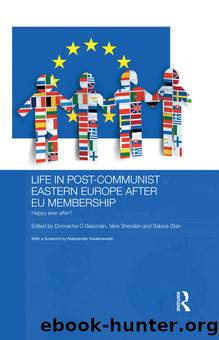Life in Post-Communist Eastern Europe after EU Membership by Donnacha O Beachain Vera Sheridan Sabina Stan

Author:Donnacha O Beachain, Vera Sheridan, Sabina Stan [Donnacha O Beachain, Vera Sheridan, Sabina Stan]
Language: eng
Format: epub
Tags: Nonfiction, Social & Cultural Studies, Social Science, Cultural Studies, Ethnic Studies
ISBN: 9781136299810
Publisher: Taylor and Francis
Published: 2012-06-25T04:00:00+00:00
Political developments
Lithuania announced the re-establishment of its independence on 11 March 1990 and commenced the transition to democracy, market economy and nation-and state-building. The Constitution was adopted in a 1992 referendum, which as a political compromise prescribed a semi-presidential form of government.3
Years of Soviet annexation thwarted democratic evolution: killings, deportations, repressions and emigration to the West changed societal structures and functions. Lithuania could be characterised as a society without a politically relevant social stratification, passive political participation and shallow party penetration (Duvold and Jurkynas, 2004). Throughout the 1990s the moderately fragmented party system consisted, at least semantically, of: two left-wing parties â the ex-communist Democratic Labour Party (Lietuvos demokratinÄ darbo partija, LDDP) and the Social Democrats (Lietuvos socialdemokratų partija, LSDP); one centre party â the Centre Union (Centro sÄ junga, CS); and two right-wing parties â the Christian Democrats (Lietuvos krikÅ¡Äionių demokratų partija, LKDP) and the Conservatives (TÄvynÄs sÄ junga, TS). In the period 1990â2000 the two main and opposing figures on the political scene were the Conservative and the ex-communist parties. The right-wing Popular Front (SÄ jÅ«dis) which later turned into the Conservative party dominated the first government, and initiated necessary structural reforms, such as the privatisation and liberalisation of the economy. However, increasing rows and splits within the Popular Front, political witch-hunting, legislative cul-de-sacs in parliament, decreasing living standards, rampant inflation and high unemployment resulted in snap elections, which yielded a four-year rule of the ex-communist LDDP. Their leader Algirdas Brazauskas won a decisive victory in the first presidential election of 1993. Despite its ex-Soviet background the Democratic Labour party spearheaded pro-capitalist and liberal socio-economic policies but failed to deliver its electoral promises, and was blamed for a series of bankruptcies in the banking sector, nomenclature-favoured privatisation and widespread corruption. Ironically, considering their communist past, LDDP policies were regarded as oriented towards big business and they did little to mitigate the increasing gulf between the rich and the poor. The only excuse the party offered was that the transition to the market economy and an inherited economic reformist programme was supported by international agencies. On the other hand, during the LDDP rule, a national currency (litas) and the Currency Board were introduced, and the litas was pegged to the US dollar at a rate of 4 to 1.4 Spiralling inflation was curbed, and from 1995 the economy began to expand. The Soviet military pulled out in August 1993 and Lithuania applied to join NATO the following year.
The bank crash in December 1995 was the final straw that broke the LDDPâs back. The Conservatives surfed on a wave of voter discontent and came to power for the 1996â2000 period. However, the economic downturn following the 1998 financial crisis in Russia, squabbles within the party and the scandal surrounding the sale of the âMažeikių naftaâ oil refinery struck a lethal blow to the Conservatives and initiated wide-ranging changes. Consequently, a liberal Lithuanian-American émigré, Valdas Adamkus, became President in 1998 and he set a deadline of five years for Lithuania to distance itself from
Download
This site does not store any files on its server. We only index and link to content provided by other sites. Please contact the content providers to delete copyright contents if any and email us, we'll remove relevant links or contents immediately.
The European History Highway: A Guide to Internet Resources by Dennis A. Trinkle Scott A. Merriman(494)
The Seven Wonders of the Ancient World by Michael Denis Higgins(477)
European Security in a Global Context by Thierry Tardy(470)
European Security without the Soviet Union by Stuart Croft Phil Williams(469)
The Routledge companion to Christian ethics by D. Stephen Long Rebekah L. Miles(458)
Hudud Al-'Alam 'The Regions of the World' - a Persian Geography 372 A.H. (982 AD) by V. V. Minorsky & C. E. Bosworth(399)
Gorbachev And His Generals by William C. Green(391)
Get Real with Storytime by Julie Dietzel-Glair & Marianne Crandall Follis(390)
Tibetan Studies in Comparative Perspective by Chih-yu Shih Yu-Wen Chen(385)
Governance, Growth and Global Leadership by Espen Moe(381)
Hyperculture by Byung-Chul Han(378)
CliffsNotes on Fitzgerald's The Great Gatsby by Kate Maurer(360)
The Oxford History of the World by Fernández-Armesto Felipe;(354)
How Languages Are Learned 5th Edition by Patsy M Lightbown;Nina Spada; & Nina Spada(353)
The Egyptian Economy, 1952-2000 by Khalid Ikram(352)
Oral Poetry and Narratives from Central Arabia: The Poetry of Ad-Dindan : A Bedouin Bard in Southern Najd (Studies in Arabic Literature, Vol 17) (English and Arabic Edition) by P. M. Kupershoek P. Marcel Kurpershoek(343)
The Oxford Handbook of the Incas by Sonia Alconini(333)
Europe Contested by Harold James(319)
The Hutchinson Dictionary of Ancient and Medieval Warfare by Peter Connolly John Gillingham John Lazenby(305)
